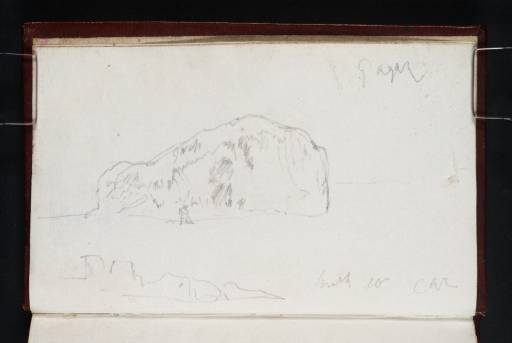Joseph Mallord William Turner Bass Rock from The 'Gegan' Rock 1818
Image 1 of 2
Joseph Mallord William Turner,
Bass Rock from The 'Gegan' Rock
1818
Joseph Mallord William Turner 1775–1851
Folio 3 Verso:
Bass Rock from The ‘Gegan’ Rock 1818
D13326
Turner Bequest CLXV 3a
Turner Bequest CLXV 3a
Pencil on white laid paper, 99 x 159 mm
Inscribed in pencil by Turner ‘Gegan’ top right, ‘G[...]’ middle and ?‘Rock [...] car’ bottom right
Inscribed in pencil by Turner ‘Gegan’ top right, ‘G[...]’ middle and ?‘Rock [...] car’ bottom right
Accepted by the nation as part of the Turner Bequest 1856
References
1909
A.J. Finberg, A Complete Inventory of the Drawings of the Turner Bequest, London 1909, vol.I, p.278, CLXV 3a, as ‘An Island – “St. Agatha”’.
1997
Eric Shanes, Turner’s Watercolour Explorations 1810–1842, exhibition catalogue, Tate Gallery, London 1997, pp.56, 57, 92 note 1.
Despite Finberg’s reading of Turner’s inscription to suggest an island called St Agatha (there are none by that name off Scotland), this is clearly (along with drawings on folios 5, 5 verso, 7, 8, 8 verso; D13329, D13330, D13333, D13335, D13336; 5, 5a, 7, 8 and 8a) as Eric Shanes suggest, the Bass Rock.1 Turner’s inscription is more likely to read ‘Gegan’, the name of a rocky outcrop opposite Tantallon Castle, and it was probably from here that he drew the Bass Rock. For the inscription on the rock itself, David Blayney Brown has suggested ‘granite’ (from which the rock is composed) or ‘gannet’ (the birds that colonise it, see folio 2; D13324; CLXV 2).2
The drawing is very close to folio 5 though drawn with a blunter pencil point to give different effects of light and shade. Turner’s numerous sketches of the rock all record slightly different information, all of which was useful to Turner in his final composite watercolour rendering, Bass Rock, circa 1824 (Lady Lever Art Gallery, Port Sunlight).3 This drawing includes a small sailing boat in front of the rock, demonstrating its vast scale. The motif was repeated in another drawing in this sketchbook (folio 7; D13333; CLXV 7), and makes its final appearance in the watercolour with a small craft of rescuers or wreckers.4
The rough sketch at the bottom of the sheet may represent the coastline around Tantallon Castle. Turner inscription at the bottom of the page ‘rocks’ and ‘car’, or ‘cap’, probably refer to the nearby rocks at Seacliff to the East of North Berwick known as ‘Car Rocks’ and ‘Great Car’, or else to the rocks nearer Scoughall called ‘Beggar’s Cap’.
A tear at the centre of the left edge has been repaired.
Thomas Ardill
October 2007
Eric Shanes suggested in his lecture to the Turner Society (‘Turner in Scotland and Turners in Scotland’, Paul Mellon Centre, London, 20 October 2007) that these are wreckers – people who scavenged from wrecked vessels or even tricked ships into crashing on the rocks in order to loot the wreckage. In his story, The Wreckers, Robert Louis Stevenson wrote about how the wreckers, or the ‘Pagans of Scoughall’, would lure ships onto the Great Car reef by tricking them with lantern lights. The lighthouse that now stands on the Bass was erected in 1902 by the civil engineering company founded by Stevenson’s grandfather.
How to cite
Thomas Ardill, ‘Bass Rock from The ‘Gegan’ Rock 1818 by Joseph Mallord William Turner’, catalogue entry, October 2007, in David Blayney Brown (ed.), J.M.W. Turner: Sketchbooks, Drawings and Watercolours, Tate Research Publication, December 2012, https://www


